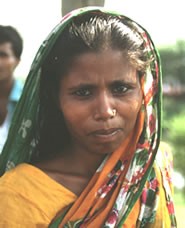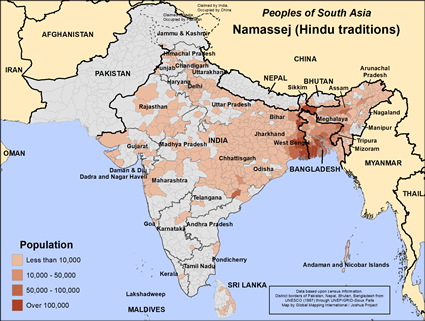Namassej (Hindu traditions) in India

Photo Source:
Copyrighted © 2026
Create International All rights reserved. Used with permission |

Map Source:
People Group data: Omid. Map geography: UNESCO / GMI. Map Design: Joshua Project.
|
| People Name: | Namassej (Hindu traditions) |
| Country: | India |
| 10/40 Window: | Yes |
| Population: | 5,414,000 |
| World Population: | 6,132,000 |
| Primary Language: | Bengali |
| Primary Religion: | Hinduism |
| Christian Adherents: | 0.48 % |
| Evangelicals: | 0.00 % |
| Scripture: | Complete Bible |
| Ministry Resources: | Yes |
| Jesus Film: | Yes |
| Audio Recordings: | Yes |
| People Cluster: | South Asia Dalit - Namassej |
| Affinity Bloc: | South Asian Peoples |
| Progress Level: |
|
Introduction / History
The Namassej are like many population groups of Bengal; they were made outcastes during the Sen Dynasty due to their defiant nature. They were hunted to southern swamps until the Europeans came. The Namassej started migrating to the central part of Bengal. The caste system which ostracizes them also to some extent protects them from mixing with other peoples. The Namassej identify themselves by their mythical clan Rishi Buddhas. They were named Namsudra during British Regime and the use of the sanction term "Chandala" was restricted by an Official Order of British-India Government. Now the community have gained acknowledgement by the name "Namassej" after the Namas Rishi, son of the great clan Rishi Buddha Kashyapa. The Namssej are found all over West Bengal, northeast Indian states and to some extent all over India.
What Are Their Lives Like?
Today they are more or less accepted, particularly among other uprooted Bengali Hindu settlements. Their cultural life is very much like an average Bengali. They are hard-working, very lively, enthusiastic, and conscious of their own identity. They are also honest, but after the division of India there has been a deterioration in their community. Their economic condition is very poor. Their literacy rate is average. The number of people with higher education is low. They are engaged in all kinds of professions but those living in villages are engaged in agriculture and animal husbandry. A small number of their population is working for the government or for private companies.
What Are Their Beliefs?
The Namssej practice Hinduism, the ancient religion of India. Their type of Hinduism is heavily influenced by folk religion. Their specific beliefs are "Matua" and they follow Harichand Thakur. They worship and serve the gods of the Hindu pantheon. Hindus believe that by performing rituals and good works that they will attain "moksha" or freedom from the endless cycle of birth, death and rebirth. The Namssej visit Hindu shrine and offer prayers, food, flowers, and incense to their gods in hopes of gaining protection and benefits. They do not have a personal or familial relationship with their gods as Christians do. There are many forms of Hinduism, each with its own deities and beliefs. The main yearly holidays of the Namssej people are Holi, the festival of colors and the start of spring, Diwali, the festival of lights, Navratri, the celebration of autumn. The caste system divides Hindus into four main categories. The Namassej are viewed as in the lowest.
What Are Their Needs?
Their basic need is for economic restoration and socio-political rehabilitation. After independence in 1947 this community has lived as uprooted refugees. A large section of this community is living below the poverty line, lacking all kinds of infrastructural facilities such as water and electricity. They need jobs and social acceptance. Most of all need to hear and understand the message of Jesus Christ. He alone can forgive their sins and bring them spiritual riches.
Prayer Points
Pray that each Namassej person has the opportunity to hear the gospel of Jesus Christ in a way that he or she can understand. Ask the Lord to send workers to the Namassej to tell them about Jesus. Pray for the Lord to raise up a disciple making movement among the Namassej in this decade.